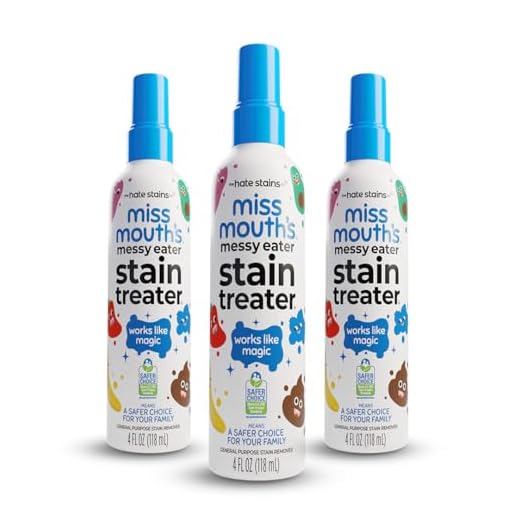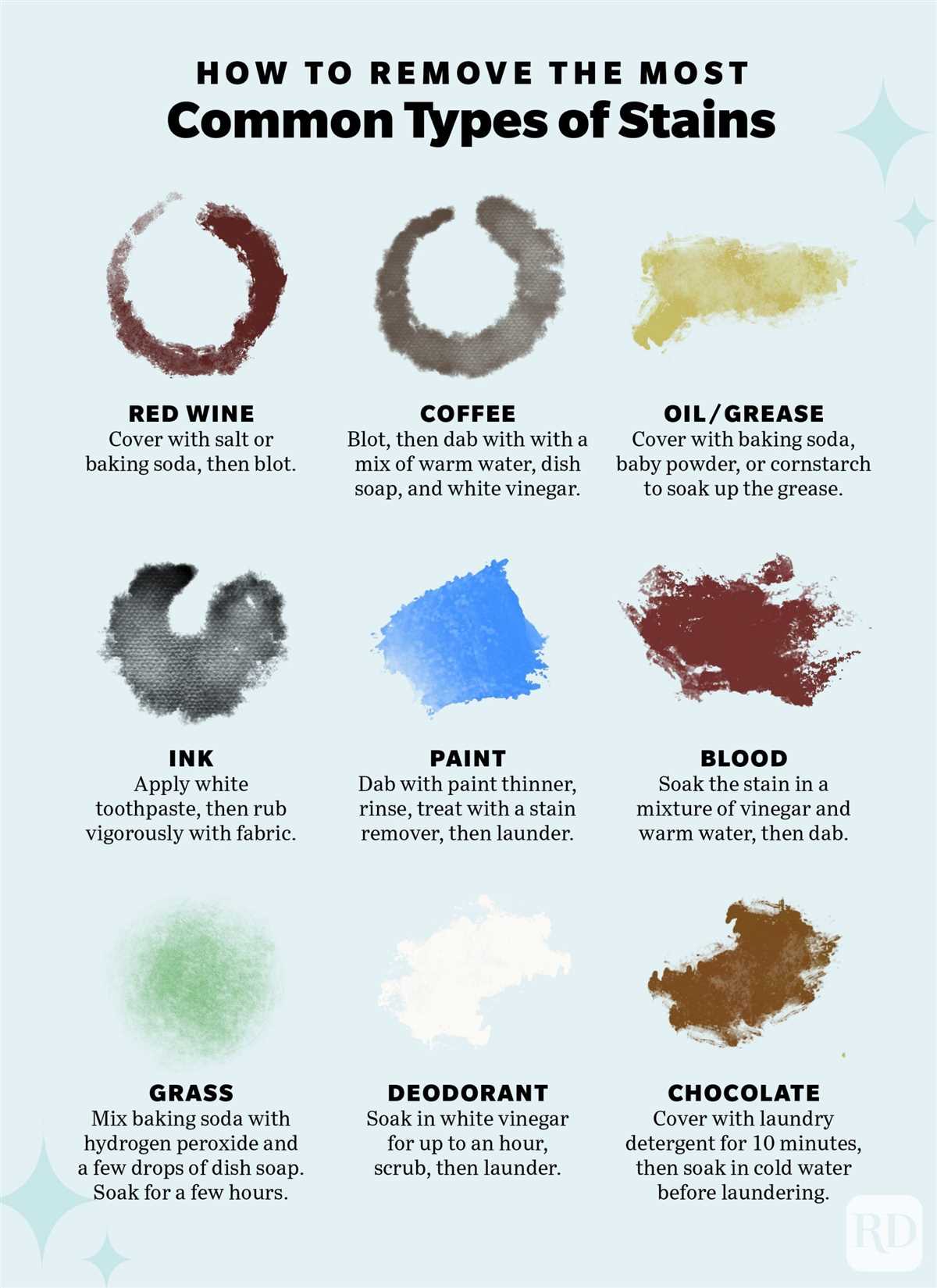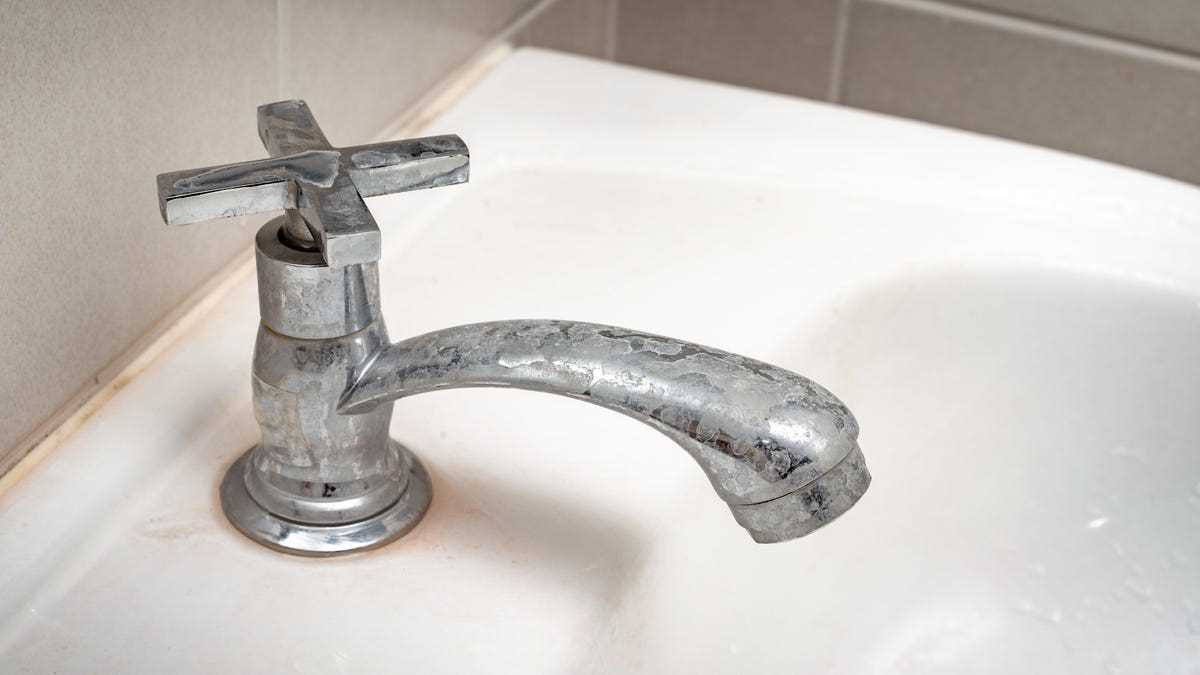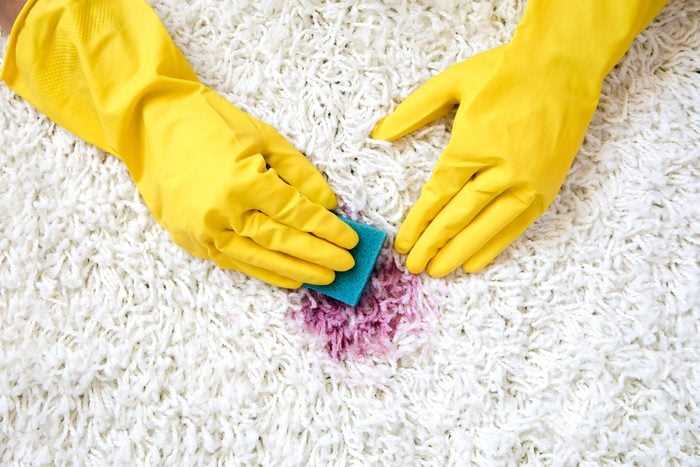




Stains can be a real headache when it comes to cleaning. While some stains may come out easily with a little soap and water, others can be quite stubborn and seem impossible to remove. Whether it’s a red wine spill on your favorite white shirt or a coffee stain on your brand new carpet, certain stains can be a real challenge to tackle.
One of the most common stubborn stains is oil-based stains. These can include grease stains from cooking, motor oil stains from your car, or even lipstick stains. Oil-based stains can be particularly challenging because oil tends to bond strongly with fabric or surfaces, making it difficult to remove. However, with the right techniques and cleaning products, you can successfully tackle these stubborn stains.
Another tough stain to remove is ink. Whether it’s a pen mark on your clothes or an accidental ink spill on your furniture, ink stains can be frustrating. Ink is designed to be permanent, so removing it requires a bit of effort. It’s important to act quickly when dealing with an ink stain and avoid rubbing it, as this can cause it to spread. Instead, blot the stain gently and use specific ink stain removal products or common household items like rubbing alcohol or hairspray to tackle the stain.
The Trickiest Stains to Get Rid Of
When it comes to removing stains, some can be a real headache. These stubborn stains seem to cling to fabrics and surfaces, making it difficult to get rid of them. Here are some of the toughest stains to remove and tips on how to tackle them:
1. Red Wine Stains

Spilling red wine on clothing or carpets can be a disaster. The pigments in red wine can quickly penetrate the fibers, leaving a noticeable stain. To remove red wine stains, quickly blot the area with a clean cloth or paper towel to absorb as much liquid as possible. Then, treat the stain with a mixture of dish soap and hydrogen peroxide. Gently scrub the stain and rinse with cold water. Repeat the process until the stain is gone.
2. Grease Stains
Grease stains can be a challenge, especially on clothing. To remove grease stains, pre-treat the area with a degreasing dish soap or a stain remover. Let it sit for a few minutes before washing the garment as usual. For more stubborn grease stains, you can also try using a mixture of baking soda and water to create a paste. Apply the paste to the stain, let it dry, and then brush off the excess before washing.
3. Ink Stains
Ink stains can ruin clothing, upholstery, and other surfaces. To remove ink stains, start by blotting the area with a clean cloth or paper towel to remove excess ink. Then, apply rubbing alcohol or an ink stain remover directly to the stain and gently blot with a cloth. For tougher ink stains, you may need to repeat the process or use a specialized stain remover. Always check the care label of the fabric before attempting any stain removal method.
4. Blood Stains
Removing blood stains can be tricky due to the protein in the blood. Begin by rinsing the stain with cold water to remove as much blood as possible. Then, apply a mixture of cold water and enzyme-based laundry detergent to the stain and gently rub. Let it sit for a few minutes before rinsing with cold water again. If the stain persists, you can also try using hydrogen peroxide or a stain remover specifically designed for blood stains.
5. Coffee Stains
Waking up to a coffee stain on your favorite shirt can be frustrating. To remove coffee stains, quickly rinse the stain with cold water to prevent it from setting. Then, treat the stain with a mixture of dish soap and water. Gently rub the stain and rinse with cold water. If the stain remains, you can also try using white vinegar or a coffee stain remover. Avoid using hot water, as it can further set the stain.
Remember, the key to removing stubborn stains is to act promptly and use the appropriate cleaning method for the specific stain and fabric. If unsure, it’s always a good idea to consult a professional cleaner for guidance.
Removing the Toughest Stains: A Guide
Introduction
Stains can be a real headache when it comes to cleaning. Some stains are more stubborn than others and require special treatment to remove them effectively. In this guide, we will discuss the toughest stains you may encounter and provide tips on how to remove them.
1. Red Wine Stains
Red wine stains can be notoriously difficult to remove, especially if they are not treated immediately. To remove red wine stains:
- Blot the stain with a clean cloth to remove any excess liquid.
- Cover the stain with salt or baking soda to absorb the remaining wine.
- After about 10 minutes, vacuum or brush off the salt/baking soda.
- Treat the stain with a mixture of dish soap and hydrogen peroxide.
- Gently scrub the stain with a soft brush and rinse with cold water.
2. Grease Stains
Grease stains can be stubborn and leave oily marks on various surfaces. To remove grease stains:
- Blot the stain with a clean cloth or paper towel to remove any excess oil.
- Apply a small amount of dish soap directly to the stain and let it sit for a few minutes.
- Gently scrub the stain with a sponge or soft brush.
- Rinse the area with warm water and repeat the process if necessary.
3. Coffee Stains
Coffee stains are common and can be challenging to remove, especially if they have dried. To remove coffee stains:
- Blot the stain with a clean cloth or paper towel to soak up as much coffee as possible.
- Apply a mixture of vinegar and water to the stain and let it sit for a few minutes.
- Gently scrub the stain with a sponge or soft brush.
- Rinse the area with cold water and repeat the process if needed.
4. Ink Stains
Ink stains can be tough to remove, but with the right approach, they can be fully eliminated. To remove ink stains:
- Blot the stain with a clean cloth or paper towel to remove any excess ink.
- Apply rubbing alcohol or hairspray to the stain and let it sit for a few minutes.
- Gently blot the stain with a cloth until the ink transfers onto the cloth.
- Rinse the area with cold water and repeat the process if necessary.
Conclusion
Stubborn stains can be a challenge to remove, but with the right techniques and products, it is possible to get rid of even the toughest of stains. Remember to act quickly, use the appropriate cleaning agents, and be gentle when treating the stains. With persistence, your fabrics and surfaces can be restored to their original condition.
Common Stains that are Hard to Remove
Whether it’s on clothing, furniture, or carpets, some stains are just notoriously difficult to remove. Here are some common stains that can pose a real challenge:
1. Red Wine Stains
Red wine stains are known for their deep color and ability to set quickly. To remove red wine stains, blot the area with a clean cloth to absorb as much liquid as possible. Then, sprinkle salt or baking soda over the stain to absorb any remaining moisture. After about 10 minutes, vacuum up the salt or baking soda and treat the stain with a stain remover or a mixture of dish soap and hydrogen peroxide. Rinse with cold water and launder as usual.
2. Oil Stains
Oil stains can be particularly stubborn, especially when they occur on fabrics. If you catch an oil stain early, blot the area with a clean cloth to remove as much oil as possible. Then, sprinkle talcum powder, cornstarch, or baking soda over the stain to absorb any remaining oil. Let it sit for a few hours or overnight before brushing off the powder. For older oil stains, you may need to use a stain remover or a mixture of dish soap and warm water. Wash the item according to the fabric’s care instructions.
3. Ink Stains
Ink stains can be a nightmare to remove, especially if they have set in. To tackle ink stains, start by placing a clean cloth underneath the stained fabric to prevent the ink from transferring to other areas. Blot the stain gently with a cloth soaked in rubbing alcohol or hairspray. Avoid rubbing the stain, as it may cause it to spread. Repeat the process until the stain is gone, then wash the item according to the fabric’s care instructions.
4. Coffee Stains
Coffee stains can leave behind visible brown marks that are difficult to remove. To treat coffee stains, blot the area with a clean cloth to absorb as much coffee as possible. Then, mix a solution of dish soap, white vinegar, and water, and gently dab it onto the stain. Let the solution sit for a few minutes before rinsing with cold water. If the stain persists, repeat the process or use a stain remover. Launder the item as usual.
5. Grass Stains
Grass stains are notorious for their ability to cling to fabrics and leave behind stubborn marks. To remove grass stains, start by pre-treating the stain with a stain remover or a paste made of baking soda and water. Let it sit for about 10 minutes before washing the item with cold water. For tougher stains, you may need to scrub the area gently with a toothbrush or use a specialized stain remover. Repeat the process if necessary and then wash the item as usual.
Remember, the key to successfully removing stubborn stains is to act quickly and avoid rubbing or scrubbing aggressively, as this can cause the stain to spread or set further into the fabric. If a stain persists, it may be best to seek professional cleaning advice or services.
Tackling Stubborn Stains: Top Tips and Tricks

Introduction
Stubborn stains can be a nightmare to deal with, but with the right tips and tricks, you can tackle them head-on. Whether it’s a coffee spill, ink mark, or grease stain, this guide will provide you with the knowledge you need to remove even the toughest stains.
1. Pre-Treat the Stain
Before you start tackling the stain, it’s important to pre-treat it. This can help loosen the stain and make it easier to remove. For most stains, a simple mixture of dish soap and warm water can do the trick. Apply the mixture to the stain and let it sit for a few minutes before moving on to the next step.
2. Choose the Right Stain-Removal Method
Different types of stains require different removal methods. Here are some common stains and how to remove them:
- Coffee Stains: Blot the stain with a mixture of vinegar and water, then wash the fabric as usual.
- Ink Stains: Place a clean cloth under the stain and dab it with rubbing alcohol using another cloth. Rinse with water and repeat if necessary.
- Grease Stains: Sprinkle baking soda or cornstarch on the stain to absorb the grease, then brush it off and wash the fabric as usual.
3. Test in an Inconspicuous Area
Before using any stain-removal method on a visible part of the fabric, it’s important to test it in an inconspicuous area first. This will ensure that the method doesn’t damage or discolor the fabric. If the test area is unaffected, you can proceed with confidence.
4. Blot Instead of Rubbing
When removing stains, it’s best to avoid rubbing the fabric. Rubbing can spread the stain and make it more difficult to remove. Instead, gently blot the stain with a clean cloth or paper towel to soak up the stain and prevent it from setting further into the fabric.
5. Follow Care Label Instructions
Always check the care label instructions on your clothing or fabric before attempting to remove a stain. Some fabrics may require special care or professional cleaning. By following the care label instructions, you can avoid causing damage to the fabric and ensure the best chance of removing the stain successfully.
Conclusion
Stubborn stains may be challenging, but with the right techniques, you can effectively tackle them. Remember to pre-treat the stain, choose the right stain-removal method, test in an inconspicuous area, blot instead of rubbing, and follow the care label instructions. Armed with these top tips and tricks, you’ll be able to conquer any stubborn stain that comes your way.
Effective Stain Removal Techniques
1. Blotting
When dealing with fresh stains, such as spilled liquids or wet stains, blotting is often the first step in the stain removal process. Use a clean cloth or paper towel to gently blot the stain, starting from the outer edges and working towards the center. This helps prevent the stain from spreading. Avoid rubbing the stain, as this can push it deeper into the fabric.
2. Pre-treating
For more stubborn stains, pre-treating the affected area can help loosen and break down the stain before washing. There are various pre-treatment options available, including stain removers, liquid detergents, or even homemade solutions. Follow the instructions on the product or apply the pre-treatment solution to the stain and let it sit for a few minutes before proceeding to the next step.
3. Soaking

For tough stains that have set into the fabric, soaking can be an effective method. Fill a basin or sink with cold water and add a scoop of laundry detergent or stain remover. Place the stained item in the solution and let it soak for several hours or overnight. This allows the cleaning agents to penetrate the stain and break it down.
4. Scrubbing
After soaking, gently scrub the stain using a soft-bristled brush or sponge. This helps to further loosen the stain and remove any remaining residue. Be careful not to scrub too vigorously, as this can damage delicate fabrics.
5. Washing
Once the stain has been treated and scrubbed, wash the item according to the fabric’s care instructions. Use the recommended water temperature and laundry detergent. Check the stain before drying, as heat can set the stain permanently.
6. Repeat if Necessary
Sometimes stubborn stains require multiple treatments. If the stain is still visible after the first round of stain removal, repeat the steps above or consider seeking professional cleaning assistance.
7. Professional Cleaning
For extremely stubborn stains or delicate fabrics, it may be best to seek the help of a professional cleaner. They have access to specialized cleaning agents and techniques that can effectively remove even the toughest stains without causing damage to the fabric.
Remember, always read and follow the instructions on the stain removal products and test them on a small, inconspicuous area of the fabric before applying them to the entire stain to ensure compatibility and prevent any damage to the fabric.
FAQ
What are the most stubborn stains to remove?
Some of the most stubborn stains to remove include red wine, coffee, ink, grease, and blood.
How do I remove red wine stains?
To remove red wine stains, you can try blotting the stain with a cloth soaked in white wine or diluted hydrogen peroxide. Then, apply a stain remover and launder as usual.
What is the best way to remove coffee stains?
To remove coffee stains, mix a solution of 1 tablespoon of liquid dish soap, 1 tablespoon of white vinegar, and 2 cups of warm water. Blot the stain with the mixture and rinse with cold water. Repeat if necessary and then launder as usual.
How can I remove ink stains?
To remove ink stains, try applying rubbing alcohol to a clean cloth and blotting the stain. You can also use a mixture of milk and cornstarch or nail polish remover. Make sure to blot, not rub, the stain. Launder as usual after treating.
What should I do to remove grease stains?
To remove grease stains, apply a small amount of dishwashing detergent directly to the stain and gently rub it in. Let it sit for a few minutes, then rinse with warm water. If the stain persists, repeat the process or use a stain remover before laundering.
What are the most common stubborn stains?
Common stubborn stains include red wine, coffee, grease, ink, and blood.
How can I remove red wine stains from clothing?
To remove red wine stains from clothing, blot the stain with a clean cloth or paper towel to absorb as much wine as possible. Then, mix a solution of one tablespoon dishwashing liquid, two cups of warm water, and one tablespoon of white vinegar. Dab the mixture onto the stain and let it sit for 15 minutes. Rinse with cool water and repeat the process until the stain is gone. Finally, wash the clothing as usual.
















